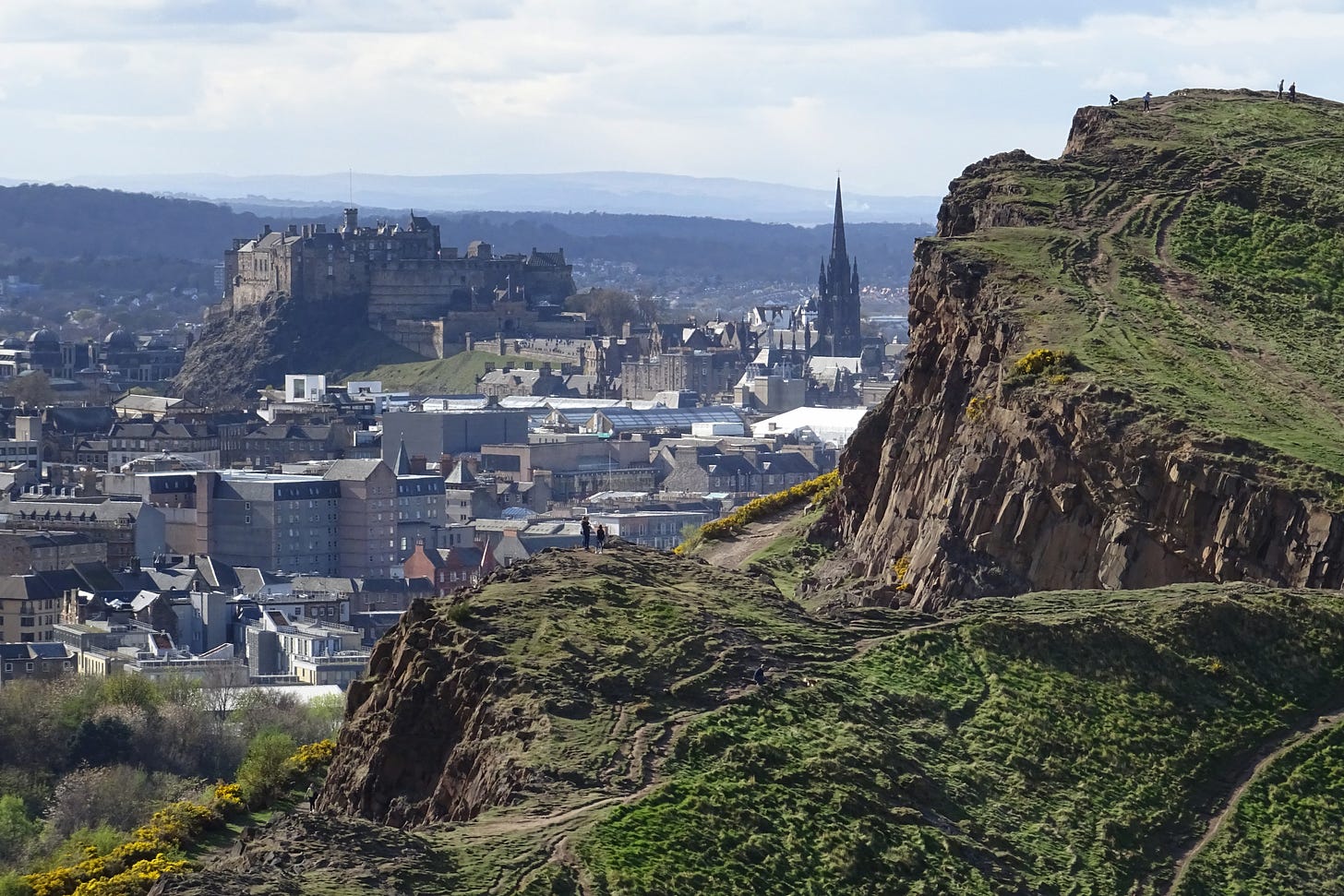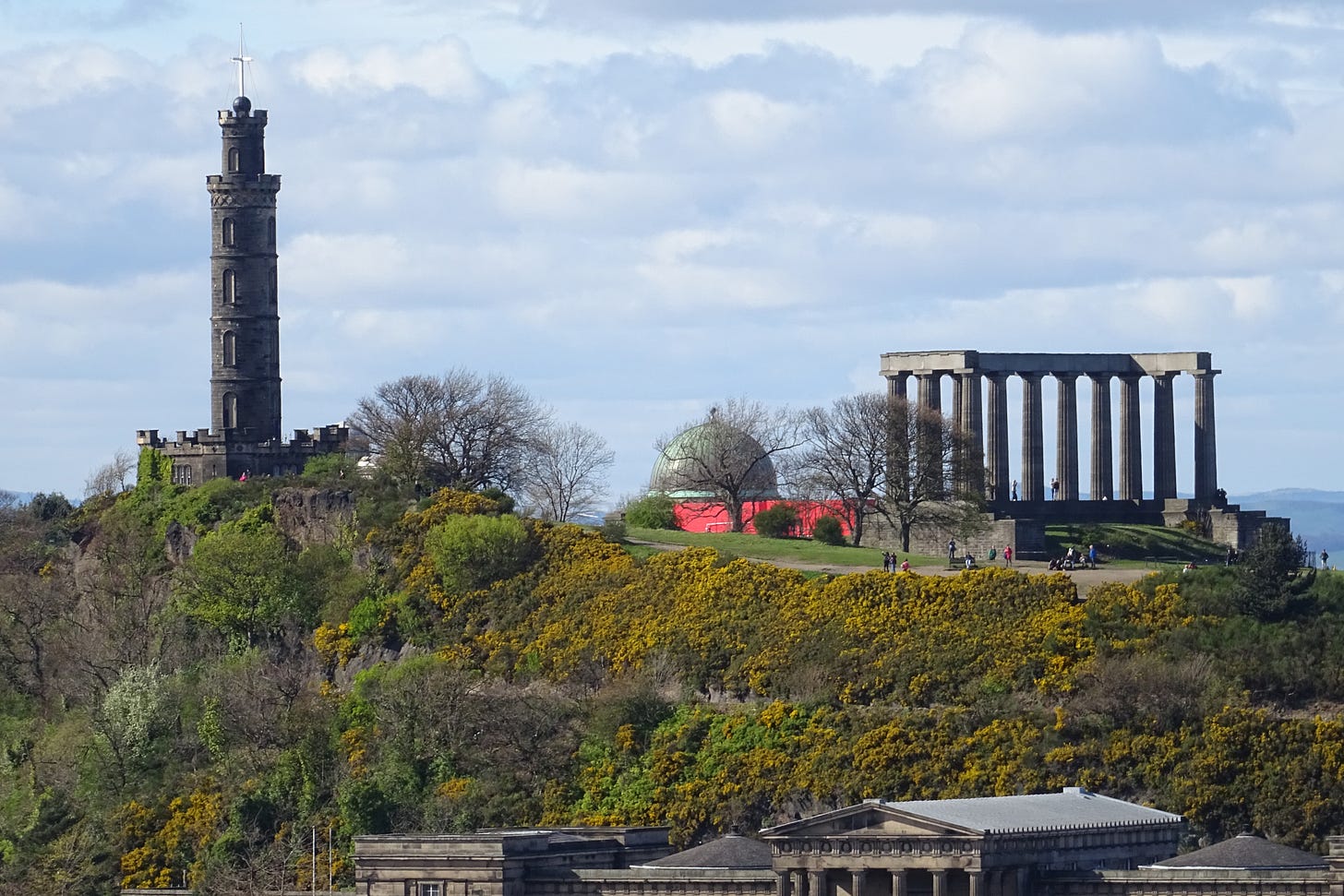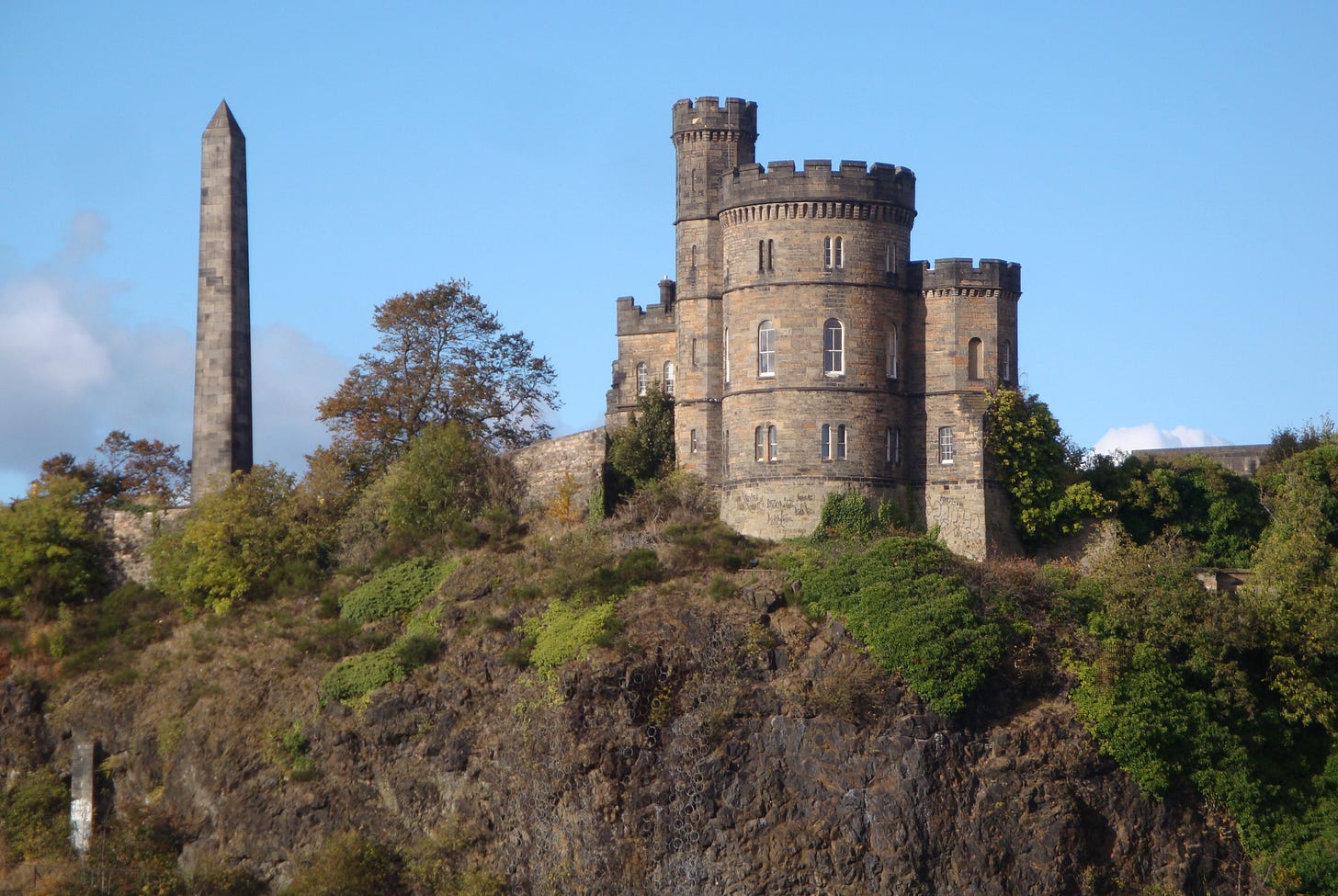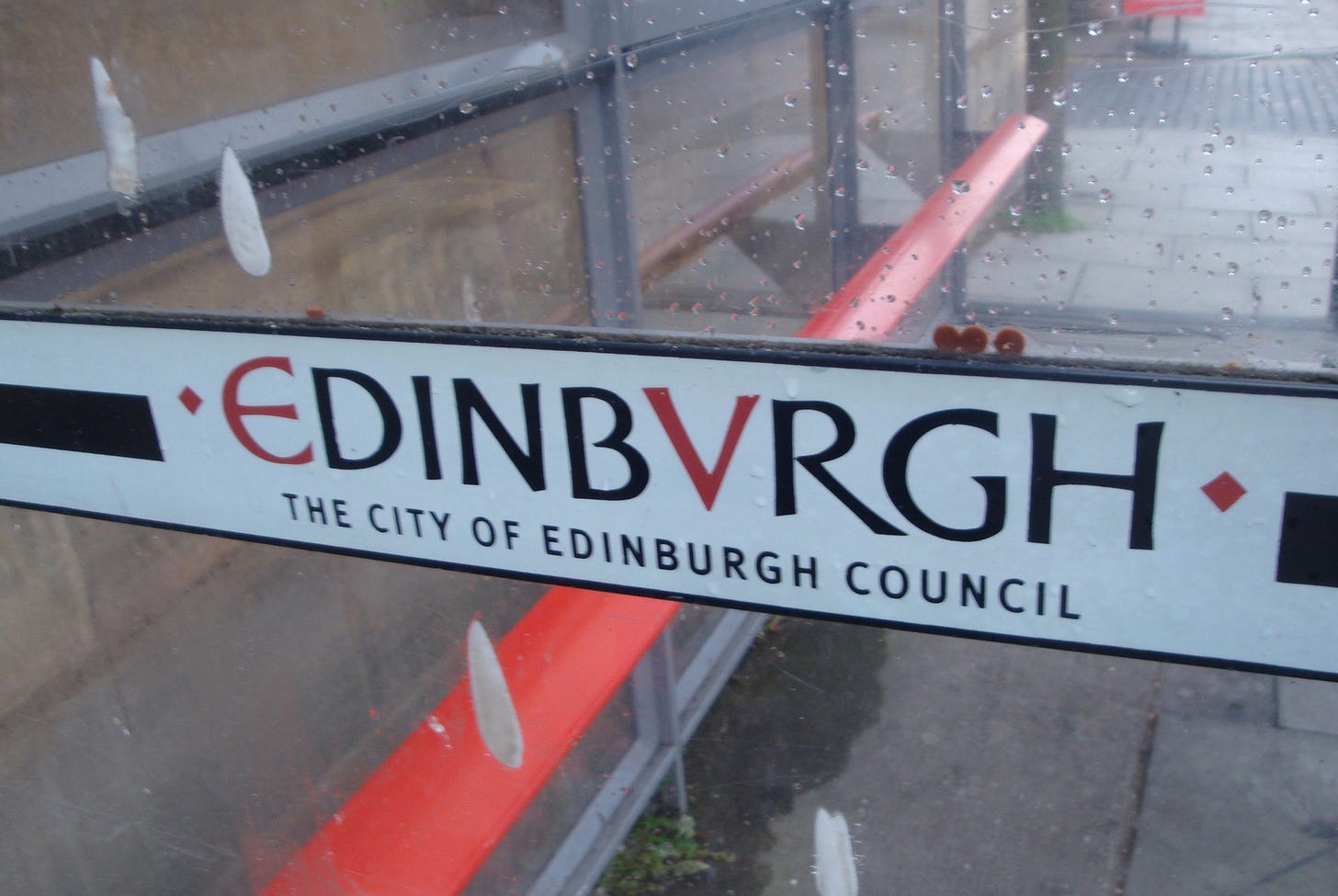I first published this post in April of last year, just for my paid subscribers. I’m now trying to catch up and release a lot of these posts so that everyone can read them. I hope you enjoy a quick trip to Edinburgh with me, pack your bags. You do have a bag, don’t you?
One of the best views of Edinburgh Castle, and, indeed, of Edinburgh itself, is from Arthur’s Seat, part of the same Carboniferous era volcano that makes up Castle Rock.
It may be a cliché to say that Edinburgh is beautiful and majestic but Edinburgh is beautiful and majestic, that’s how it became a cliché. Of course, Edinburgh is a city, so parts are dirty and graffitied; there’s peeling paint, boarded windows and ill-advised concrete structures. However, on a bright, warm afternoon from the top of Arthur’s Seat the view across the city’s spires and crenallations to Calton Hill with its pillared National Monument and the City Observatory is, well, beautiful and majestic. More similar adjectives follow as your eye sweeps across the harbour and the Port of Leith to the saltire blue waters of the Firth of Forth and the distant hills of Fife and Perthshire and Angus.
If you are ever in Edinburgh, particularly if it’s a pleasant afternoon with fluffy cumulus floating through the blue sky, you must climb Arthur’s Seat. Until you’ve seen them for yourself, you can’t imagine how wonderful the views are from here to the three bridges over the Forth, across the city and round to the beach at Musselburgh. The rock is over eight hundred feet above the waters of the Forth which spread before you to the north and east, that means that the visible horizon is over thirty miles away on a clear day.
No-one really knows why Arthur’s Seat is called Arthur’s Seat. Of course, King Arthur is the obvious candidate and some even think that this is the location of Camelot but it’s probably more likely that it’s a corruption of an earlier Gaelic name. It was around here, by Arthur’s Seat, at Salisbury Crags, that James Hutton essentially invented the idea of geology, all of the rocks I talked about back in December.
In the middle of the eighteenth century when most of the world believed, like about forty percent of Americans today, that God had created the earth in less than a week, James Hutton put forward the theory that the rocks around us were not created as we see them today but have undergone changes throughout countless millennia. It took him twenty-five years of studying these rocks and contemplating how they might have been created before he published his snappily titled Theory of the Earth; or an Investigation of the Laws observable in the Composition, Dissolution, and Restoration of Land upon the Globe.
Okay, he might not have been great at thinking up punchy names for books but I could have stared at these rocks from the moment they were formed from that volcano three-hundred-and-odd million years ago until a week last Thursday and I still couldn’t have come up with the theories he did. The modern science of geology is pretty much down to him and the basic principles that he put forward still hold true.
One City - Two Towns
You can see right across the two towns of Edinburgh from here. The Old Town, as it’s known, grew up on the ridge below the castle with just one main street and lots of narrow closes or wynds leading off it. The Old Town was constrained by its geography and as the population grew, its buildings grew upwards, sometimes reaching nine storeys high. Lawnmarket on the approach to the castle still has plenty of sixteenth century six-storey buildings. Today the shops on the ground floor cater to the upmarket visitors with enough cashmere and whisky to keep every American tourist who thinks they have Scottish ancestry warm for eternity.
It wasn’t always this way, the closes leading off the main street would have had no plumbing. Water would have been brought from public wells and human effluent would have been…well, if you were in a sixth storey bedroom and had a chamber pot to empty, I bet you didn’t always take the stairs. When Dr Johnson arrived in Edinburgh on the fourteenth of August 1773 to meet Boswell and head off on their tour of Scotland and the Isles, he had the misfortune to have a chamber pot emptied over him on the way to meet Mrs Boswell. Around about the same time, the town council bought the farmland to the north of here and twenty-six year old architect John Craig designed the wide straight streets and open spaces that you can still see today in the New Town. Together they make a marvellous capital city.
I am very fond of Edinburgh and one of the reasons for that is books; the city in real life is just like the city in books. It is the Edinburgh of Dr. Jekyll and Mr. Hyde; it is the Edinburgh of Rebus; it is the Edinburgh of Andrew Macleod; it is even the Edinburgh of Emma and Dexter. The bricks and mortar Edinburgh is the Edinburgh of the imagination. You can picture the castle, the views from Arthur’s Seat, the old town and its narrow wynds, the many monuments and ancient buildings. They are all here, just the way you dreamed them. Other places in fiction and the images they conjure in our minds are generally greater than the actual place when we visit. The real places are a let-down but not here, as H.V. Morton notes, Edinburgh: “cannot be exaggerated”.
If you visit London, you will not, unless you are certifiably insane or American, expect to find Holmes around the next corner. If you go to my hometown of Salford, you won’t meet Harry Hardcastle. However, if you go to Edinburgh, you’re never far from glimpsing Miss Jean Brodie or Dr Wolfe Macfarlane and you are very likely to spot someone who may well be Renton or Begbie. Speaking of whom, again the influence of Edinburgh on a book and a series of movies is unsurprising when we get to Trainspotting, as the city certainly has more than its fair share of the chemically adventurous. You can’t get far down Princes Street without encountering someone shouting at the world, staring fixedly at nothing or sleeping in an unlikely place. Princes Street is one of the world’s great thoroughfares, though. One side is shops, like any other high street, but the other side is gardens, galleries and a great ravine with a view of the volcanic plug on which Edinburgh Castle sits.
On Edinburgh’s streets, as with the streets of most towns and cities, you’ll find buskers but – even outside the festival – they’re some of the best. Scotland is particularly blessed with buskers. Glasgow has some of the most talented. Dundee has the loudest and scariest buskers, very good but only a second away from turning on you and beating the money out of you. Edinburgh’s buskers are the most fun; particularly Marcello Vacante who has now, unfortunately, used the money raised on Princes Street to move to London. I’m not sure I’d have bothered, given the choice of capital cities of the United Kingdom, this is the one I’d choose to stay in.
I like Edinburgh no matter what the season or what the weather. It doesn’t matter whether it is a cloudless June evening with the golden sun spilling over the buildings and people sitting around in Princes Street Gardens or a damp October morning with the tram tracks glistening from overnight rain and people with upturned collars hurrying through the gloom to get to work, Edinburgh is glorious. It always looks like the opening of a novel. From the massive monuments on Calton Hill glimpsed behind the impressively expansive glass roof of Waverley station to the faded old signs you’ll find in doorways or the entrances to alleyways, it is all just magnificent.
I like the signs of Edinburgh. All across the city, especially on things like bus stops, you see signs which read “EDINBURGH – THE CITY OF EDINBURGH COUNCIL”. Now, I appreciate that this probably wasn’t meant to be a motto or anything because, if it was, it is the worst ever. They might just as well have gone for “EDINBURGH – A CITY THAT BEGINS WITH E” or, if that was too welcoming for the chemically inclined, “EDINBURGH – A PLACE IN SCOTLAND”. I hope that it wasn’t supposed to be a motto as with its rich history, all of the great sons and daughters of Edinburgh and it being the seat of parliament and the capital of a nation, they could have gone for something better.
They don’t put a lot of thought into their signs in Edinburgh, though. When you arrive at the airport and walk up the stairs from your aeroplane there is a sign which reads: “NO DOGS – EXCEPT GUIDE DOGS AND DOGS TRAVELLING WITH PASSENGERS”. Now, as this is airside at a major UK airport, precisely which dogs were they hoping to exclude? I know that police dogs and the sniffer dogs used by immigration are allowed there so the only dogs that the sign actually pertains to are those dogs who are travelling independently by air and can read signs written in English. For the number they must get, I’m not sure it’s worth having the sign.
On my way home, travelling through the airport, I got talking to the lady in the luggage shop. My main question was:
"Who the hell buys luggage at this point in their trip?"
Surely by the time you reach the airport, you have already solved the conundrum of whether or not you need luggage. I wanted to know if she saw lots of people carrying two weeks’ worth of clothes in their arms with their toothbrush in their top pocket saying, "Hey, you know what we need? We need a bag."
She looked at me like I was a bit strange, but I'm used to that, and said they sold lots of bags. She estimated that they sold a thousand bags a week, at which point I relaxed as I could see that it was her who was mad, not me, as that must be a bag every five minutes and I’ve never seen anyone buy one.
She went on to say that just seconds prior to my arrival, she had sold a suitcase for £675. I coughed and choked a little on the news. She insisted that they were good value as they'd last me a long time. I pointed out that I travelled most weeks and the bag I had with me cost £40 and had so far lasted me four years. To even equal that, her bag would need to still be travelling weekly with me when I was 115. She didn't speak to me after that and busied herself tidying already tidy displays. I guiltily bought a clip that attaches your coat to your bag and left.










